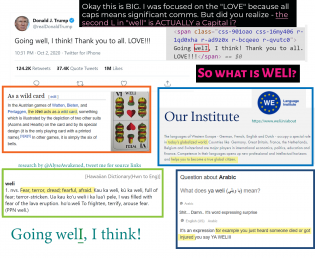Difference between revisions of "Weli"
Tag: 2017 source edit |
Tag: 2017 source edit |
||
| Line 5: | Line 5: | ||
| − | === Misspellings matter === | + | ===Misspellings matter=== |
[[File:Drop 831.png|border|left|thumb|226x226px]] | [[File:Drop 831.png|border|left|thumb|226x226px]] | ||
We know that misspellings matter in comms - Drops #831 and #3704 confirm this, among others. So, let's take a look first at the word itself - WELI. There are many different results for this word, and I'll try to start on an analysis of each of them and what they could mean. Feel free to add additional insights. | We know that misspellings matter in comms - Drops #831 and #3704 confirm this, among others. So, let's take a look first at the word itself - WELI. There are many different results for this word, and I'll try to start on an analysis of each of them and what they could mean. Feel free to add additional insights. | ||
| Line 15: | Line 15: | ||
<br /> | <br /> | ||
| − | == Connections == | + | ==Connections== |
| + | [[File:Weli.jpg|thumb|A ''Weli'' from a William Tell pack of cards]] | ||
| + | The '''''Weli''''', formerly '''''Welli''''', is a [[playing card]] used in the Salzburg and [[William Tell deck|William Tell card decks]], which are [[Austria]]n regional patterns of the [[German playing cards|German-suited playing cards]]. It has the value of 6 of Bells and, in the [[South Tyrol]] variant of the card game, [[Watten (game)|Watten]], it is the only 6 used and can, in addition to its own suit of Bells, join the trump suits of Acorns, Hearts and Leaves. In all other variants of Watten, the 7 of Bells is the ''Weli''. | ||
| + | |||
| + | == History == | ||
| + | |||
| + | The ''Weli'' is also often called the ''Welli'' or ''Belli'' and, dialectically, the ''Wöli'', ''Wöüli'' or ''Belle''. The name ''Weli'' probably comes from the Italian word ''belli'', which means "bells". | ||
| + | |||
| + | Historically the ''Weli'' is first recorded in the early 1850s, when a [[Bolzano|Bozen]] card manufacturer inscribed ''WELLI'' onto the six of bells. As early as 1855, the ''Weli'' was integrated in the Salzburg pattern as the 6 of Bells.<ref>[https://i-p-c-s.org/pattern/ps-46.html Later Tyrol pattern] at the [[International Playing-Card Society]]</ref> The gravestone appearing in many depictions is probably the grave of the [[Paul of Tarsus|Apostle Paul]]. | ||
| + | |||
| + | In the game of [[Jaggln]], the Six of Bells is usually called the ''Buggl'' (Austrian dialect for ''Buckel'', a hump or rounded object, perhaps referring to the shape of the bells).<ref>Schipflinger, Anton (1927). "Das Jaggln" in ''Tiroler Heimatblätter'', Issue 7/8, pp. 230/231.</ref> | ||
| + | |||
| + | ===Weli, the wild card=== | ||
| + | In the Austrian games of Watten, Bieten, and Perlaggen, the ''Weli'' acts as a [[Wild card (card games)|wild card]], something which is illustrated by the depiction of two other suits (Acorns and Hearts) on the card and by its special design (it is the only playing card with a printed name).<ref>McLeod, John. [https://www.pagat.com/trumps/watten.html Watten] at [[pagat.com]]. Retrieved 1 June 2018.</ref><ref>McLeod, John. [https://www.pagat.com/last/bieten.htm Bietenl] at [[pagat.com]]. Retrieved 1 June 2018.</ref><ref>McLeod, John. [https://www.pagat.com/trumps/perlaggen.html Perlaggen] at [[pagat.com]]. Retrieved 1 June 2018.</ref> In other games, it is simply the six of bells. | ||
| − | |||
<br /> | <br /> | ||
| − | + | ||
| + | == References == | ||
| + | <references /> | ||
Revision as of 21:53, 3 October 2020
On Sat Oct 03, 03:31:34, President Donald Trump sent out this tweet:
All-caps usually indicates a significant comm - in this case LOVE. But what turned out to be even more notable was a bizarre "typo" - spelling "well" with a capital letter i in place of a second L. This has been verified both by examining the source code of the tweet, as well as the blockchain-verified record of its content.[1]
Misspellings matter
We know that misspellings matter in comms - Drops #831 and #3704 confirm this, among others. So, let's take a look first at the word itself - WELI. There are many different results for this word, and I'll try to start on an analysis of each of them and what they could mean. Feel free to add additional insights.
Connections
The Weli, formerly Welli, is a playing card used in the Salzburg and William Tell card decks, which are Austrian regional patterns of the German-suited playing cards. It has the value of 6 of Bells and, in the South Tyrol variant of the card game, Watten, it is the only 6 used and can, in addition to its own suit of Bells, join the trump suits of Acorns, Hearts and Leaves. In all other variants of Watten, the 7 of Bells is the Weli.
History
The Weli is also often called the Welli or Belli and, dialectically, the Wöli, Wöüli or Belle. The name Weli probably comes from the Italian word belli, which means "bells".
Historically the Weli is first recorded in the early 1850s, when a Bozen card manufacturer inscribed WELLI onto the six of bells. As early as 1855, the Weli was integrated in the Salzburg pattern as the 6 of Bells.[2] The gravestone appearing in many depictions is probably the grave of the Apostle Paul.
In the game of Jaggln, the Six of Bells is usually called the Buggl (Austrian dialect for Buckel, a hump or rounded object, perhaps referring to the shape of the bells).[3]
Weli, the wild card
In the Austrian games of Watten, Bieten, and Perlaggen, the Weli acts as a wild card, something which is illustrated by the depiction of two other suits (Acorns and Hearts) on the card and by its special design (it is the only playing card with a printed name).[4][5][6] In other games, it is simply the six of bells.
References
- ^ @realDonaldTrump via tweetstamp.org
- ^ Later Tyrol pattern at the International Playing-Card Society
- ^ Schipflinger, Anton (1927). "Das Jaggln" in Tiroler Heimatblätter, Issue 7/8, pp. 230/231.
- ^ McLeod, John. Watten at pagat.com. Retrieved 1 June 2018.
- ^ McLeod, John. Bietenl at pagat.com. Retrieved 1 June 2018.
- ^ McLeod, John. Perlaggen at pagat.com. Retrieved 1 June 2018.



